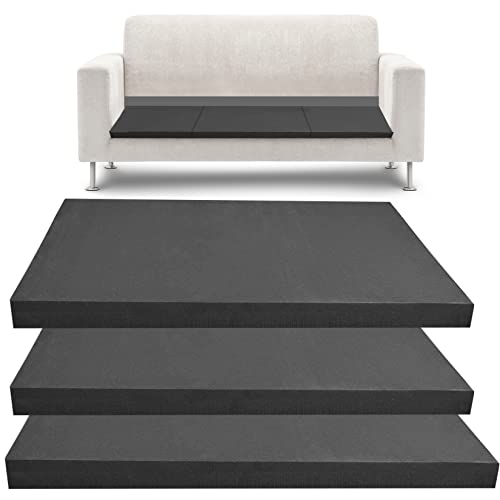How to sort out sagging couch cushions – for a soft, and comfortable couch
Give your uncomfortable couch a new lease of life with these expert-approved tips to fluff up flat cushions


It can be easy to think that a sagging couch – that's flat, lifeless and uncomfortable, is a sign you need a replacement. After all, there's nothing cozy about settling down and snuggling up on a hard cushion.
But, with a little expert know-how it's possible to re-plump your cushions and restore your couch to it's former glory. So, whether you have previously invested in the best couch and do not want to replace it yet, or have recently picked up a secondhand steal, you can get yours looking good as new.
Here, I spoke to interiors experts for their tips on repairing your saggy couch cushions, and how to prevent them in the future – to get your comfy couch back without breaking the bank.
How to fix sagging couch cushions
1. Rotate and flip the cushions

One of the best, easiest and most effective ways to fix sagging couch cushions is to regularly remove, flip and rotate them, to ensure you aren't consistently sitting in the same spot.
Artem Kropovinsky, interior designer and founder of studio Arsight, begins, 'This simple action, while it might appear trivial, is usually the initial tactic in resolving the issues of drooping cushions, especially if you have never flipped them before.'
Importantly, this technique works by redistributing the stuffing, helping to balance out the wear, preventing the cushions from dropping in one spot, while being full in another.
Victoria Holly, interior designer at Victoria Holly Interiors, recommends, 'Regularly flipping and rotating your cushions every one to two months to help prevent uneven wear,' which is something I do at home to make my couch look more expensive.
'For down, or down alternative cushions, give them a gentle punch and re-style them to redistribute the filling,' she adds.
2. Add in some extra soft stuffing

If flipping and rotating is not enough to rejuvenate your sagging couch cushions, and you want to keep up with the latest sofa trends, then adding extra stuffing them is the next best bet – and is cheaper than having to replace the whole cushion. For a quick fluff-up, you can pick up couch cushion stuffing, such as Jupean Fiber Fill at Walmart or number one bestselling Fairfield The Original Poly-Fil available at Amazon.
And, if you need a longer-lasting solution, Magda Callery, interior designer and founder of Style by Magda, says, 'For more lasting support, go with foam inserts. Fiberfill gives a little lift, but foam gives serious structure.'
Foam lengths, such as the Mybecca High Density Upholstery Foam Cushion available at Amazon, should be purchased at around the length of your couch cushion, or preferably longer, so they can be trimmed down to size. Add the foam one layer at a time to each cushion, testing it with each addition until you get the right support and comfort that you're looking for.
Interior designer Holly explains, 'For cushions that hold their shape over time, look for high-density foam with a bounce back – you want the foam to be able to bounce back easily once you get up.
'If you want firmer cushions, consider adding a layer of batting around high-density foam, or using a firm foam core filled with softer fill for comfort.
If you have a feather-stuffed couch, your cushions may be sagging as a result of feathers falling out, advises Tracy Metro, renowned interior designer, and host of interior design show House Doctor on Netflix US. 'This is an easy fix,' she says. 'You can buy a bag of feathers and stuff them into the cushion envelope.'

To do so, we recommend using the East Coast Bedding Bulk 10/90 Goose Down Feather Blend available at Amazon, which is a superior, high-quality fill with that's Responsibly Down Standard (RDS) certified. This ensures the down and feathers are ethically sourced and processed.
Additionally, your sagging couch cushions may be caused by a fabric issue, if the weave of your woven fabric is stretching, contributing to an old, weathered look.
If this is happening, Metro explains, 'How can you stop the fabric from stretching and sagging? You can knit back the fabric, which will stabilize the weave and stop it from giving.' If you're not handy with a sewing machine or knitting needles, you can drop your cushions off at a tailors.
Once stuffed, your cushion cover may be tricky to close, but try not to force any zips to prevent them from ripping. Instead, have someone hold the cushion cover closed, squishing the foam, before pulling the zip closed over the top.
3. Beat the cushions to loosen compacted fillings

Another thing I always try to do to give a little life back to my heavily used sofa is to beat the cushions to help reshape them. Although this may sound damaging, all I do is place the couch cushion standing up on the floor with the longest edge on the rug. Holding it firmly, I then hit the front and back of the cushions firmly with the other hand repeatedly to re-fluff them.
This works best for couch cushions with looser stuffing that has compacted down over time, but it is also a good way to clean a couch, its cushions and bang out any dust and crumbs.
If you've got one to hand, you may also want to use a rug beater, such as the REDECKER Rattan Reed Carpet Beater available at Amazon for this step, as the large paddle will effectively redistribute filling.
4. Consider a sofa topper for temporary support

Sofa toppers are really a last resort for fixing your sagging couch cushions, as they can look a little out of place in well-designed living rooms ideas. Nevertheless, a topper can help to provide a little extra firmness and plushness without opening up the cushions, designer Kropovinsky recommends.
He says, ‘Various toppers are available, so choose one that suits your preferences and budget, and try to find one that matches the aesthetics of your room.’

These sofa savers are brilliant to bring your couch back to life, and are customizable, durable, water and weather-resistant.
FAQs
How can you prevent couch cushions from sagging?
Sagging couch cushions are part of the natural life cycle of your sofa and are a natural consequence of you sitting on them every single day. However, there are a few things you can do to try to slow the sagging process.
'Make friends with rotation,' says interiors expert Callery. 'While tempting, avoid plopping down on the same cushion every time you binge-watch. It needs a break too!'
You can also prevent your couch cushions sagging in the first place by investing in the best couch you can afford.
Jennifer Ebert, digital editor here at Homes & Gardens explains, ‘Where your budget allows, you should also pick couch cushions made of high-quality, natural materials from some of the best places to buy couches. These are more likely to last longer, and will be easier to fluff and refill if needed in the future.’
Can sagging couch cushions be repaired even if they have visible indents?
'Absolutely,' says interiors expert Callery. 'If your cushions have visible indents, they're not doomed. Start by removing the insert and adding a little foam or extra fiberfill to reshape things.
'Add high-density foam inserts or a layer of batting for really stubborn sagging, and they’ll look as good as new. A little extra stuffing at the corners doesn’t hurt, either – it’s the cushion version of Botox!'
And, if you need to stop couch cushions from slipping, consider using non-slip furniture pads, such as the Premium Furniture Pads available at Amazon to keep everything in place.
Although there is no way of completely preventing couch cushions from sagging, investing in a good couch (and knowing how much you should spend on a sofa to ensure longevity) as well as caring for your couch cushions correctly with regular rotations will help to delay the deterioration.
If you have re-plumped your cushions and you still find the couch sagging, then it may be the base springs in your sofa that have given out. If this is the case, consider having an upholsterer restring the sofa, or, alternatively, use a hard seat saver pad beneath the cushions to provide a little extra support.
Sign up to the Homes & Gardens newsletter
Design expertise in your inbox – from inspiring decorating ideas and beautiful celebrity homes to practical gardening advice and shopping round-ups.

Chiana has been at Homes & Gardens for two years and is our resident 'queen' of non-toxic living. She spends most of her time producing content for the Solved section of the website, helping readers get the most out of their homes through clever decluttering, cleaning, and tidying tips. She was named one of Fixr's top home improvement journalists in 2024.
-
 How to get rid of bean seed flies – a pest control expert reveals how to keep crops safe from these seed munchers
How to get rid of bean seed flies – a pest control expert reveals how to keep crops safe from these seed munchersAs their name implies, these insects primarily feed on bean crops
By Tenielle Jordison
-
 Sarah Michelle Gellar's kitchen cabinets are moody yet elevated – I've always used dark paint with caution, but they make bolder tones accessible
Sarah Michelle Gellar's kitchen cabinets are moody yet elevated – I've always used dark paint with caution, but they make bolder tones accessibleThe actress's black kitchen cabinets are bold yet palatable, proving that this dark shade is a trendy yet timeless color pick
By Hannah Ziegler
-
 5 surprisingly practical ways to re-purpose old bed sheets for cleaning, decluttering and storage at home
5 surprisingly practical ways to re-purpose old bed sheets for cleaning, decluttering and storage at homeDon't ditch worn-out bedding – there's life in them yet
By Natasha Brinsmead
-
 Do you need to turn the lights off when you leave a room? Experts have ended this time-honored debate once and for all
Do you need to turn the lights off when you leave a room? Experts have ended this time-honored debate once and for allOn or off? We delve into the details of this age-old dispute
By Chiana Dickson
-
 I tried the baking soda trick to quickly and naturally clean my outdoor rug – it’s now set for Easter outdoor hosting
I tried the baking soda trick to quickly and naturally clean my outdoor rug – it’s now set for Easter outdoor hostingBaking soda is perfect for lifting dirt and debris
By Eve Smallman
-
 The 5 worst things you can do to your fridge – these will drive up energy costs and result in pricey and regrettable repairs
The 5 worst things you can do to your fridge – these will drive up energy costs and result in pricey and regrettable repairsIt's crucial to swerve these blunders, appliance experts warn
By Ottilie Blackhall
-
 Extend the lifespan of your appliance with 5 simple but crucial washing machine maintenance tips
Extend the lifespan of your appliance with 5 simple but crucial washing machine maintenance tipsFrom cleaning the filters to keeping the door open, experts reveal the washer tips they swear by
By Andy van Terheyden
-
 5 vital ways a home battery backup can help with your most urgent needs in a power outage – from heating to flood prevention and calls
5 vital ways a home battery backup can help with your most urgent needs in a power outage – from heating to flood prevention and callsExperts say they're a worthy investment
By Clement Feng
-
 I’m an HVAC technician, and this is when I turn on my AC each year – plus 5 checks I always do beforehand
I’m an HVAC technician, and this is when I turn on my AC each year – plus 5 checks I always do beforehandSave yourself an AC hassle by running my checks and turning it on before big heat hits
By Josh Mitchell
-
 6 things you should never throw in the trash – and what to do for safe disposal instead
6 things you should never throw in the trash – and what to do for safe disposal insteadFrom batteries to space heaters, experts reveal what not to throw
By Andy van Terheyden